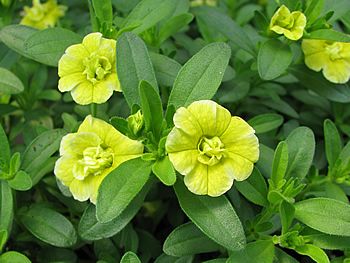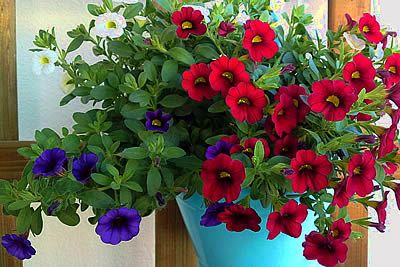Calibrachoa or Million Bells (Calibrachoa x hybrida) is a herbaceous and flowering plant, native to South America. Despite being perennial, it has a short lifespan. It is very similar to the Petunia (Petunia x hybrida), being related to this other species and originating from the same habitat.

Often, such similarities create confusion in their identification. However, it has recently been scientifically elucidated that these two species differ in their chromosome numbers and reproductive mechanisms. Crossbreeding between the two species is possible, generating the vigorous hybrid genus Petchoa, with large flowers.
With dense, branched foliage that spreads and is often pendant, calibrachoa forms a small, rounded, low bush that usually does not exceed 30 centimeters in height, but depending on the cultivar, can form bushes up to 50 centimeters. Its leaves are entire, simple, elliptical to spatulate, pubescent, and green in color. The flowers are trumpet or bell-shaped, like petunias, but smaller.
They come in a huge range of colors and combinations, from degradeés, to striped and speckled, according to the cultivar. They can also be simple or double. The flowers are highly attractive to bees and hummingbirds. The fruits formed after pollination are capsule type, with tiny seeds. They are rare in hybrid plants, and more common in native species.
Calibrachoa has become increasingly popular, especially after the creation of the “Million Bells” hybrids in the United States, which elevated the plant’s status and made it successful in Garden Centers worldwide. They are wonderful plants for planting in pots, planters, and especially in hanging baskets.

They can be used in mass plantings or borders, in solid color cultivations, mixed or even in combinations with other plants, always with a very showy and colorful effect. The “cascade” effect they produce makes them an excellent choice for eye-level admiration, such as on top of walls and slopes, for example.
Their growth is rapid, and maintenance involves pinching the tips during growth for densification of the plant, and pruning to remove old flowers at the end of summer, thus stimulating new flowering. If well-managed, it can bloom from spring to autumn.
It should be grown in full sun or partial shade, in fertile, well-drained soil, enriched with organic compost and watered regularly, allowing the soil to dry superficially between watering. It tolerates light frosts, short dry periods, and heat. Despite being perennial, it is generally grown as an annual or biennial, as it loses beauty and vigor over time, necessitating replanting.
It requires good amounts of fertilizers, with a recommendation to mix organic fertilizers with slow-release fertilizers and some liquid fertilizer during the growing and flowering period, without excess, but with constant supply. It can be propagated by cutting the tips and seeds, which are sown or rooted in autumn, and kept in greenhouses during the winter, to start flowering in spring.


